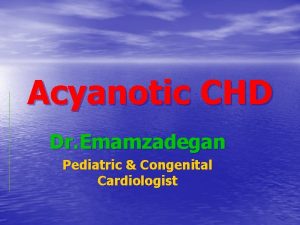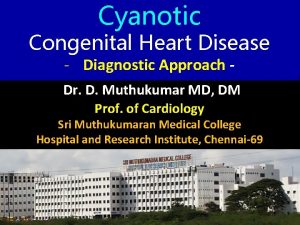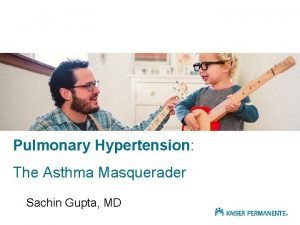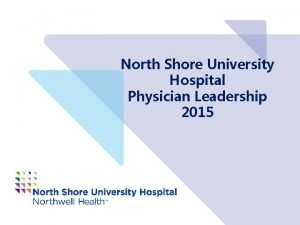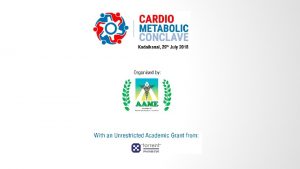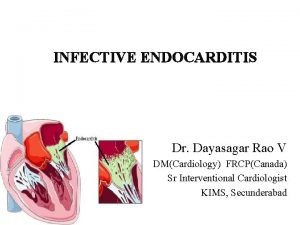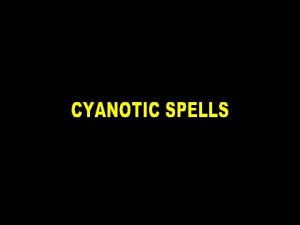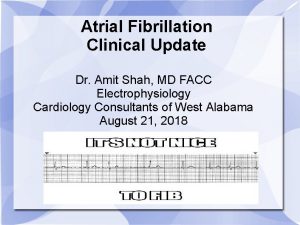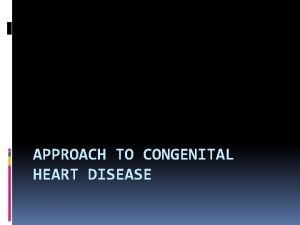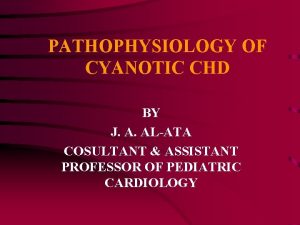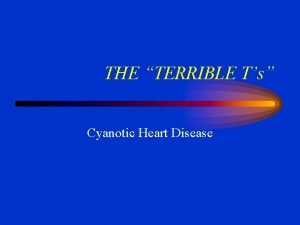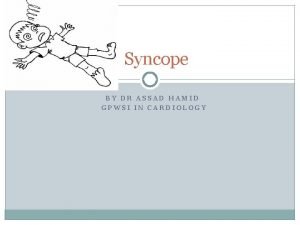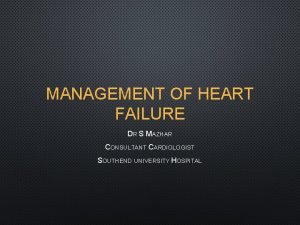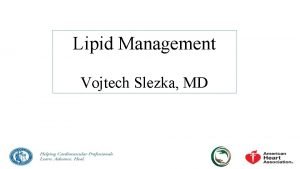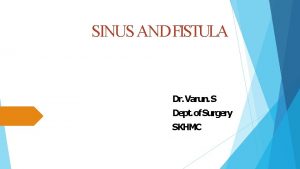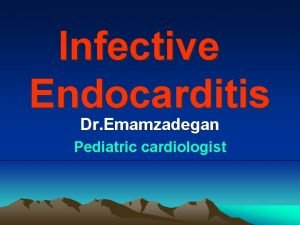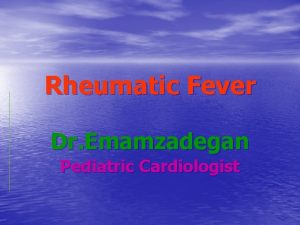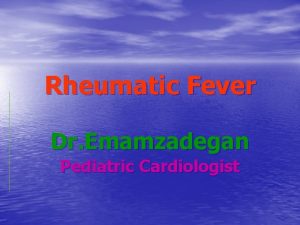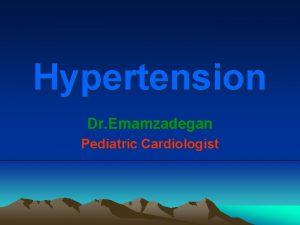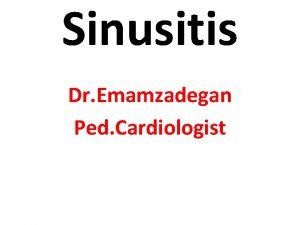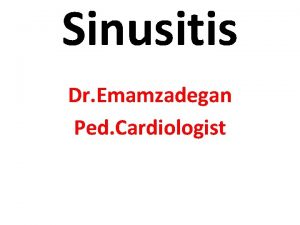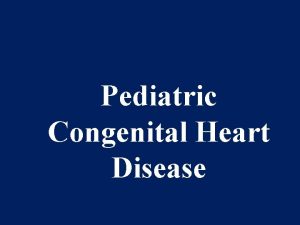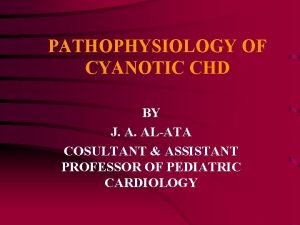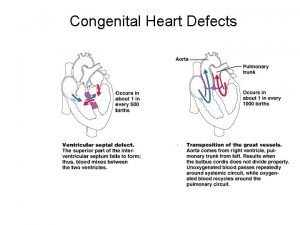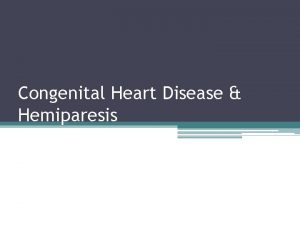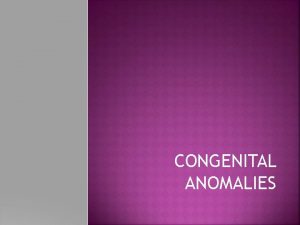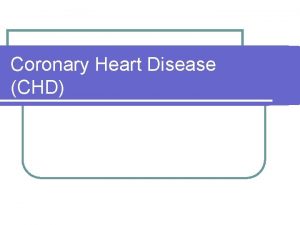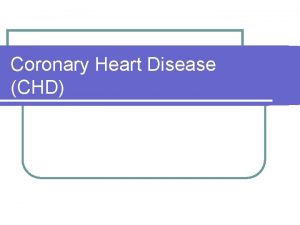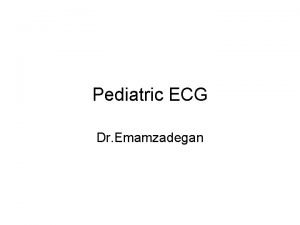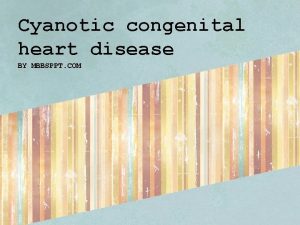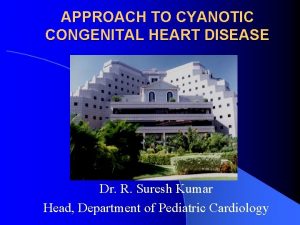Cyanotic CHD Dr Emamzadegan Pediatric Congenital Cardiologist Cyanotic





















- Slides: 21

Cyanotic CHD Dr. Emamzadegan Pediatric & Congenital Cardiologist

Cyanotic CHD # Etiology : Rt to Lt shunt s: o 2 sat < 85% , 5 g/dl of reduced Hgb in systemic blood # Anemia: decreased cyanosis Polycythemia: increased cyanosis #The most common type: 5 T(TOF; Truncus arteriosus; d-TGA; Tricuspid Atresia; TAPVC)

Cyanotic CHD # Cyanosis with respir. distress: increased pulm. blood flow (d-TGA) # Cyanosis without respir. distress: decreased pulm. blood flow (TOF) # Hypoperfusion: TAPVC with obstruction; AS; HLHS; CMP

Tetralogy Of Fallot # The most common cyanotic CHD(10%) S(the most common: infundibular) ; VSD (sub Ao); Ao overriding ; RVH(secondary)

Tetralogy Of Fallot Clinical Manifestation: # degree of cyanosis: amount of PS # Initial MM: PS (upper LSB) #S 2 : Single , RV impulse in LSB #Hypoxic spell (blue spell, tet spell , hypercyanotic spell): s, agitated, loss of murmur , perpnea, unconsciousness , seizure, hemiparesia , death

Tetralogy Of Fallot # Complications: brain abscess ; cerebral thromboembolism # ECG: RAD, RVH # CXR: boot shaped heart , PVM↓

Tetralogy Of Fallot Treatment: Spell: Knee chest position, O 2, morphine , phenylephrine, Inderal, SBE prophylaxis, ……. TFTC(5% LAD from RCA, crossing RVOT) Blalock-Taussig shunt (subclavian to PA)

D-TGA # 5% of CHD most common cyanotic CHD to present in the newborn period: d-TGA # Mixing : atrial, ventricular, PDA # cyanosis: amount of mixing #S 2: single(A 2)

D-TGA # d-TGA/IVS: no MM, severe cyanosis d-TGA/VSD: mild cyanosis , HF, loud mm # ECG: RAD, RVH # CXR: PVM↑ , egg on string atment: PGE 1, Rashkind balloon eptostomy, surgery of choice (Arterial switch) within 2 weeks of life.

Tricuspid Atresia # 2% of CHD Hypoplastic RV, Rt to Lt shunt at ASD level, VSD is necessary Severe cyanosis, single S 2, frequently no significant MM( VSD MM, diastolic MM of MV)

Tricuspid Atresia # ECG: LVH, superior axis(0 to -90)LAD # CXR: NL size of heart or mild ↑ PVM ↓ # Treatment: Shunt (Blalock-Taussig): subclavian to PA Glenn (SVC to RPA) Fontan (IVC to PA)

Truncus Arteriosus # Single arterial trunk arises from heart with large VSD, pulmonary arteries arise from trunk. # Cyanosis: amount of pulm. Flow # CHF: tachypnea , cough # Pulses: bounding ngle , SMM(LSB), systolic ejection click

Truncus Arteriosus ECG : CVH CXR: PVM↑, PA may appear displaced Digoxin +diuretic>>>>surgery

TAPVC # Disruption of development of PV during 3 week of gestation. # Typing: supracardiac, infra, mixed # ASD with Rt to Lt shunt is necessary

TAPVC Clinical manifestations: 1. Without obstruction 2. With obstruction

1. Without obstruction Mild cyanosis, may be asymptomatic, continuous murmur, wide s 2 split, systolic ejection MM (upper LSB) ECG: RVH, RAD CXR: C/T & PVM ↑

2. With obstruction achypnea, dyspnea, Rt heart failure (hepatomegaly), no MM ECG: RAD, RVH CXR: C/T= Normal, pulmonary edema (HMD, pneumonia)

HLHS # The most common cause of death during neonatal period from CHD. #Hypoplastic LV, hypoplasia of ascending aorta& Ao arch. # Lt to Rt shunt at ASD level, Rt to Lt shunt at PDA level, retrograde flow in AAO.

HLHS Clinical manifestations: pulses=weak, S 2 =single & loud No MM, Mild cyanosis Grayish color, cool & mottled skin If PDA constricts: CHF & death

HLHS ECG: RVH CXR: C/T ↑ , pulmonary edema Treatment: PGE 1, correction of acidosis, vent. support, >>> Norwood , Glenn, Fontan

Extracardiac complications of cyanotic CHD 1. Polycythemia 2. Anemia 3. CNS abscess & emboli 4. Gingival disease 5. Gout(polycythemia & diuretic) 6. Clubbing(hypoxia) 7. Infectious disease (asplenia; Di George; RSV) 8. FTT
 Tetralogy of fallot xray
Tetralogy of fallot xray Congenital cardiologist near me
Congenital cardiologist near me Eisenmenger syndrome
Eisenmenger syndrome Cjanoza
Cjanoza Sachin gupta md
Sachin gupta md Chd meridian healthcare
Chd meridian healthcare Certification study guide: certified hvac designer (chd)
Certification study guide: certified hvac designer (chd) Dr burton rochelson
Dr burton rochelson Dr sriram rajagopal cardiologist
Dr sriram rajagopal cardiologist Dr nolan cardiologist
Dr nolan cardiologist Cardiologist in kodaikanal
Cardiologist in kodaikanal Dr. dayasagar rao v
Dr. dayasagar rao v Cyanotic spells
Cyanotic spells Dr amit shah cardiologist
Dr amit shah cardiologist Cyanotic vs acyanotic
Cyanotic vs acyanotic Dr siegfried cardiologist
Dr siegfried cardiologist Cyanotic spells
Cyanotic spells Terrible t's cyanotic heart disease
Terrible t's cyanotic heart disease Dr nick gall cardiologist
Dr nick gall cardiologist Dr mazhar cardiologist
Dr mazhar cardiologist Dr slezka
Dr slezka Sinus vs fistula
Sinus vs fistula

